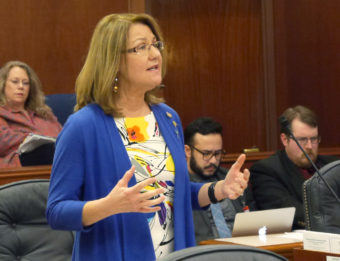Much of the state government’s budget would be paid using the Permanent Fund’s earnings under a bill the Senate Finance Committee introduced Tuesday. It also would reduce Permanent Fund dividends, but could make them more stable for the future.
The bill could help move state government away from a decades-long dependence oil revenue.
Senate Bill 128, which is based on Gov. Bill Walker’s proposal, would pay about $2.5 billion from the Permanent Fund toward the budget, rising to $3 billion in eight years.

It wouldn’t completely close the budget gap, but it would reduce state draws on the budget reserves enough that Senate Finance Committee Co-Chair Anna MacKinnon, R-Eagle River, believes it would put the state on sounder financial footing.
“I do think that we can come together on this portion, this leg of the journey, in helping the creditors that are watching Alaska,” she said. “I think this is a huge step forward. We diversify our revenue stream by almost 40 percent under this proposal.”
Dividend checks would be $1,000 for the next three years, and similar amounts after that. Walker has said that without changes to current law, the checks could disappear in as little as three years.
Legislative Finance Director David Teal says the bill would increase the state’s financial stability. The deficit would fall from more than $3 billion this year to less than $500 million in six years.
“The reserve balance is slightly lower but your deficit is so much lower that your glide path is much better under this bill than under the current status quo,” Teal said.
The bill is similar to other so-called “percent of market value” bills. It calls for 5.25 percent of the fund’s market value to be paid to the state. Of that payment, 20 percent would be devoted to dividends, with the rest going to the budget. In addition, about 15 percent of oil royalties would also support dividends.
Revenue Commissioner Randall Hoffbeck was cautiously positive toward the bill, saying that it gives the administration and Legislature something to work with.
“We have a mechanism now for using the earnings reserve,” he said. “And that’s a major step forward and we’re excited to start working on it.”
Wasilla Republican Sen. Mike Dunleavy said he thinks the latest bill shouldn’t be the final word on the state government’s finances. He wants a legal limit on spending.
“This is the opportunity to really take advantage of it and put some brakes on our desire to spend,” Dunleavy said. “I’ve probably heard a thousand different reasons why we should spend more money. Even though we’re at this point more than $4 billion less revenue than we’ve had in the past.”
MacKinnon says the bill is the results of months of work by legislative staff. She wants it to be something that will draw support in the Legislature and from Walker – without relying on an income tax.
“We’re looking for consensus in both bodies as well as with the administration,” MacKinnon said. “The idea is to stabilize Alaska’s income stream and protect Alaskans.”
The Senate Finance Committee plans to hold a hearing on the bill on Wednesday. Both houses have until the scheduled end of the session on Sunday to pass the bill.
